This blog post is an extension of my December 14, 2012, post, which addressed damage mitigation provisions and a couple different ways that carriers try to wield the insured’s mitigation efforts against the insured. Here is some more food for thought.
First, I have found this correlation holds true more often than not – the more time that passes without mitigation, the more health and safety hazards arise. If health and safety hazards are a reasonably possible consequence of delayed mitigation, it is my opinion that carriers will be even more hard-pressed to justify claim denial based on your prompt mitigation efforts.
Second, I would be remiss if I did not caution that the wording of mitigation and subrogation provisions sometimes conflicts (please read your policy carefully), and there exist pro-insurer judges who might decide on summary judgment that a subrogation provision trumps the mitigation provision. Such judges might throw the time-tested contractual doctrine of contra proferentem to the wayside and decide the insured’s mitigation efforts stymied the insurer’s subrogation exploration. Take a look at a Chip Merlin post on this subject: Subrogation Rights—Potential Danger Zone for Policyholder Coverage.
For the good reasons articulated in Chip’s post, there does not appear to be any Florida decisions similar to the New York decision featured in Chip’s post, and there are no decisions (Florida or otherwise) that cite to the New York decision. Regardless of the anomalousness of the New York decision, heed Chip’s advice to get approval from the insurer before mitigating. As I wrote two weeks ago – if the circumstances allow, contemporaneously report the claim and advise the carrier of your prospective mitigation plan.
To read previous posts in my series on insurance policy conditions, click here. Oh, and more thing … I invite audience participation in this blog series – please let me know if there is a particular condition or a precise condition-related issue that you would like for me to write about.



